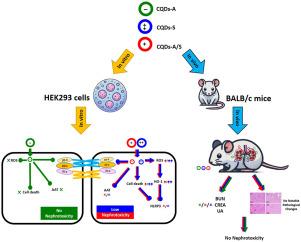Comprehensive evaluation of the nephrotoxicity of carbon quantum dots: Effects of the surface charge
IF 8.1
2区 环境科学与生态学
Q1 ENVIRONMENTAL SCIENCES
引用次数: 0
Abstract
Carbon quantum dots (CQDs) are garnering attention for their broad applications. This study offers a detailed evaluation of the biomedical safety and health risks of carbon quantum dots (CQDs) with different surface modifications, addressing a key gap in their safe application. It focuses on three CQD types: diammonium citrate-based (CQDs-A), spermidine trihydrochloride-based (CQDs-S), and a combination (CQDs-A/S), analyzing their physicochemical properties, cytotoxicity, oxidative stress, inflammatory responses, and nephrotoxicity. While all CQDs were under 10 nm, their biological impacts varied. Positively charged CQDs-S and CQDs-A/S showed significant cytotoxicity in HEK293 cells, inducing oxidative stress but not activating NLRP3 inflammasome, indicating a limited inflammatory response. Renal integrity remained unaffected, with stable zonula occludens 2 expression and unaltered renal markers. In vivo studies in BALB/c mice further supported the safety of CQDs, showing no organ damage or kidney pathology at high doses. The findings underscore the potential for safe biomedical use of CQDs, particularly when their retention time is minimized. This research makes a novel contribution by linking CQDs' surface charge to cytotoxic effects and oxidative stress, providing key insights into their safe use in biomedicine and filling a critical gap in nanoparticle toxicity studies.

全面评估碳量子点的肾毒性:表面电荷的影响
碳量子点(CQDs)因其广泛的应用而备受关注。本研究详细评估了经不同表面修饰的碳量子点(CQDs)的生物医学安全性和健康风险,解决了其安全应用方面的一个关键缺口。研究重点关注了三种类型的碳量子点:柠檬酸二铵型(CQDs-A)、三盐酸亚精胺型(CQDs-S)和组合型(CQDs-A/S),分析了它们的理化性质、细胞毒性、氧化应激、炎症反应和肾毒性。虽然所有的 CQDs 都在 10 纳米以下,但它们对生物的影响却各不相同。带正电荷的 CQDs-S 和 CQDs-A/S 在 HEK293 细胞中显示出显著的细胞毒性,可诱导氧化应激,但不会激活 NLRP3 炎症小体,这表明炎症反应有限。肾脏完整性未受影响,闭锁带 2 表达稳定,肾脏标志物也未发生变化。在 BALB/c 小鼠中进行的体内研究进一步证实了 CQDs 的安全性,研究显示,高剂量 CQDs 不会造成器官损伤或肾脏病变。这些发现强调了 CQDs 安全用于生物医学的潜力,尤其是当其保留时间最小化时。这项研究将 CQDs 的表面电荷与细胞毒性效应和氧化应激联系起来,为 CQDs 在生物医学中的安全使用提供了重要见解,填补了纳米粒子毒性研究的一个重要空白,从而做出了新的贡献。
本文章由计算机程序翻译,如有差异,请以英文原文为准。
求助全文
约1分钟内获得全文
求助全文
来源期刊

Chemosphere
环境科学-环境科学
CiteScore
15.80
自引率
8.00%
发文量
4975
审稿时长
3.4 months
期刊介绍:
Chemosphere, being an international multidisciplinary journal, is dedicated to publishing original communications and review articles on chemicals in the environment. The scope covers a wide range of topics, including the identification, quantification, behavior, fate, toxicology, treatment, and remediation of chemicals in the bio-, hydro-, litho-, and atmosphere, ensuring the broad dissemination of research in this field.
 求助内容:
求助内容: 应助结果提醒方式:
应助结果提醒方式:


